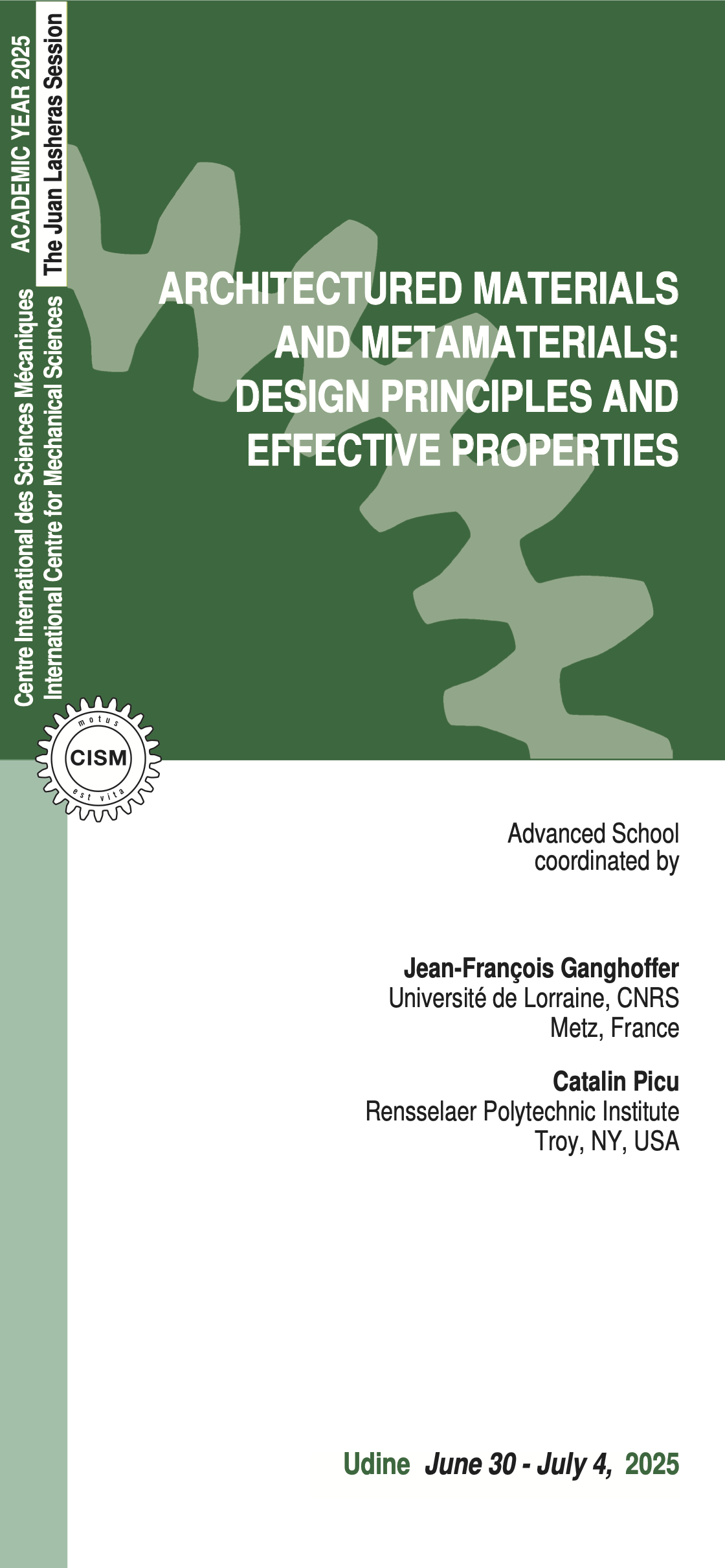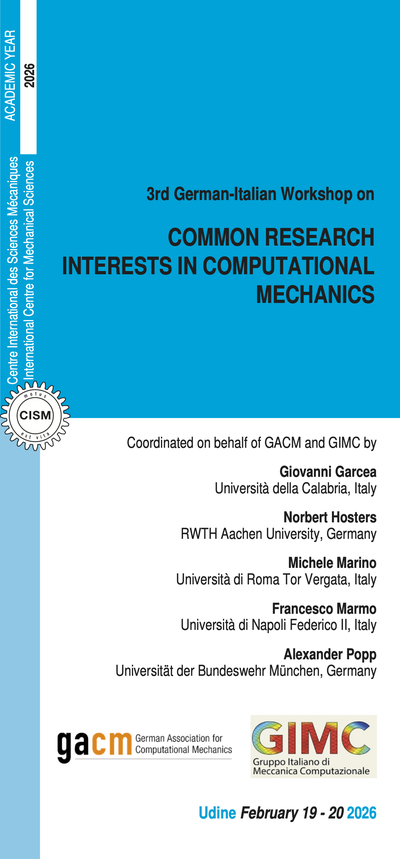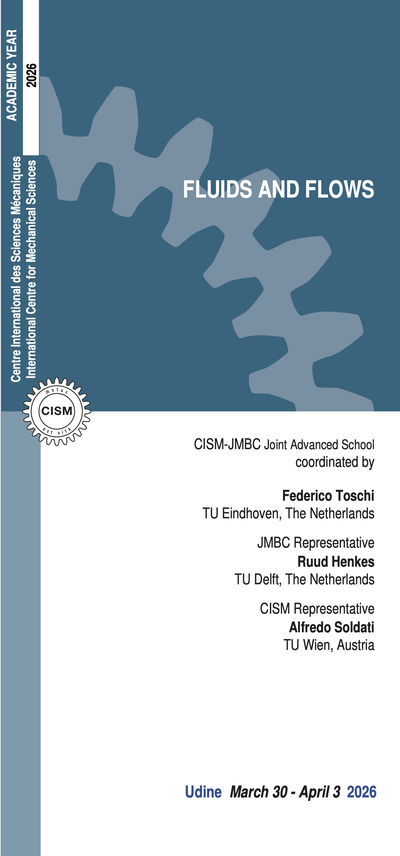The advancement of additive manufacturing making possible the creation of complex multiscale architectures controlled from the nano / micro level led to a new paradigm in the design of materials. Architected materials (AM) derive their properties not from the ones of their base material, but rather from the design and topology of their microstructure. Amongst architected materials, the category called metamaterials indicate materials with pre-designed multiscale architecture that exhibit unusual static and dynamic properties associated with large local deformations, the presence of multiple metastable states, and instabilities.
For the effective mechanical and acoustic properties of AM to be determined, a link between the microstructural and the scale of an effective substitution medium needs to be set relying on suitable homogenization schemes; generalized continuum models like micromorphic or strain gradient media are sometimes needed to account for the special microstructural deformation modes.
Creating architectures of controlled anisotropy tuned to be ultra-soft or ultra-stiff and lightweight has become increasingly important in biomechanical, civil, and mechanical engineering applications. For instance, specific biological structural members such as tendons and ligaments exhibit Poisson's ratio values well above the isotropic limits, thereby highlighting the need for biomimetic metamaterial microstructures, appropriate for tendon or ligament restoration processes. Fibrous materials are a class of AM that includes many biological and engineering examples, named collectively network materials. Connective tissue in human and animal bodies, paper, cellulose products, nonwovens, and textiles, are all network materials. Their behavior is highly non-linear and is defined by the presence of metastable states, instabilities, and ultimately, by the network architecture. Network materials are tough, damage resistant; they may be designed and built to exploit unusual static and dynamic properties and such systems belong to the class of metamaterials.
Topologically interlocked materials form a distinct class of AM. They are composed of periodic building blocks which are assembled to tesselate space. The contacts between blocks control the highly non-linear behavior of the ensemble on the macroscopic scale. These materials are damage-resistant and tough, and exhibit interesting behaviors in shear, indentation and under dynamics loads.
The objective of the course is to bring together researchers from the modeling, computational and experimental mechanics communities to expose an overview, including recent research activities, of the rapidly expanding field of architectured materials, with a special focus on mechanical metamaterials in both statics and dynamics. The proposed course targets both established researchers and a younger audience and will provide state-of-the-art information in this area.
E. Alavi, J.F. Ganghoffer, H. Reda, M. Sadighi, Construction of micromorphic continua by homogenization based on variational principles. J. Mech. Phys. Solids, 153:104278, 2021. DOI:10.1016/j.jmps.2020.104278.
N. Karathanasopoulos, G. Arampatzis, J.F. Ganghoffer. Unravelling the viscoelastic, buffer-like mechanical behavior of tendons: A numerical quantitative study at the fibril-fiber scale. J. Mech. Beh. Biomed. Mat. DOI: 10.1016/j.jmbbm.2018.10.019.
S. Deogekar, R.C. Picu, On the strength of random fiber networks, J. Mech. Phys. Sol., Vol. 116, pp. 1-16, 2018.
T. Siegmund, F. Barthelat, R. Cipra, E. Habtour, J. Riddick, Manufacture and mechanics of topologically interlocked material assemblies, Applied Mechanics Reviews 68 (4), 040803, 2016.
S. Varanasi, J.S. Bolton, T.H. Siegmund, R.J. Cipra, The low-frequency performance of metamaterial barriers based on cellular structures, Applied Acoustics 74 (4), 485-495, 2013.
AE Viard, J Dirrenberger, S Forest. Propagating material instabilities in planar architectured materials. Int. J. Solids Struct., 202, 532-551, 2020.
Placidi L, Emilio Barchiesi, Anil Misra, Dmitry Timofeev (2021). Micromechanics-based elasto-plastic–damage energy formulation for strain gradient solids with granular micro-structure. Continuum Mechanics and Thermodynamics, 33, p. 2213-2241, ISSN: 0935-1175, doi: 10.1007/s00161-021-01023-1.
R.C. Picu, Network materials: structure and properties, Cambridge Univ Press, 2022.
5 lectures on: Design, manufacturing and computational aspects of architected materials and metamaterials.
Design and manufacturing of architectured materials and metamaterials. Computational mechanics for architectured materials and metamaterials. Instabilities in architectured materials. RVE size of stochastic architectured materials.
5 lectures on: Static and dynamical behavior of architected materials considering size effects - Applications in biomechanics.
Micromechanical models of architected materials and metamaterials. Introduction to multiscale topology optimization methods – Case of auxetics. Plastic and collapse properties of network materials and size effects. Tendons and bone.
5 lectures on: Network materials as architectured materials and metamaterials.
Mechanical behavior of stochastic network materials: small and large strains. Damage accumulation and rupture; strength and toughness. Role of architecture in network materials. Structure-properties relations. Biological, engineering applications.
5 lectures on: Effective properties of elastic and dissipat ive metamaterials.
Granular micromechanics to calculate effective properties of metamaterials. Micromechanics homogenization for pantographic structures. Dynamic behavior. Reversible elastic and irreversible damage and plastic properties. Fatigue response of metamaterials.
6 lectures on: Multiphysical behavior of architected materials.
Piezoelectric and flexoelectric response of AM. Homogenization schemes in the multiphysical contex. Enriched constitutive models: Cosserat, micromorphic. Large strains models of soft AM. Vibration and wave propagation aspects in metamaterials.
6 lectures on: Metamaterials through topologically interlocked building blocks.
Tessellations, periodicity, and periodicity for building block assemblies. Mechanics of periodic topological interlocked assemblies. Strength and toughness. Mechanics of nonperiodic topological interlocked assemblies. Emerging properties.





